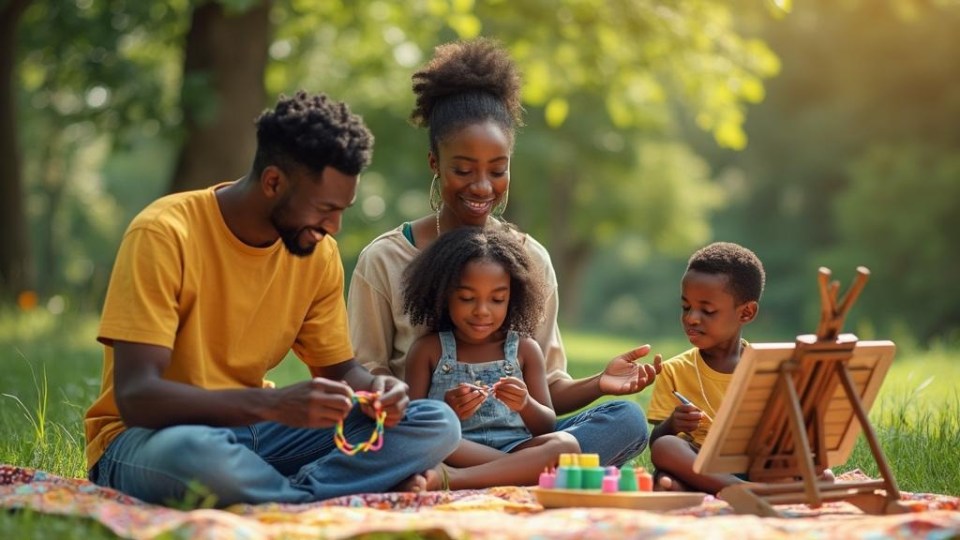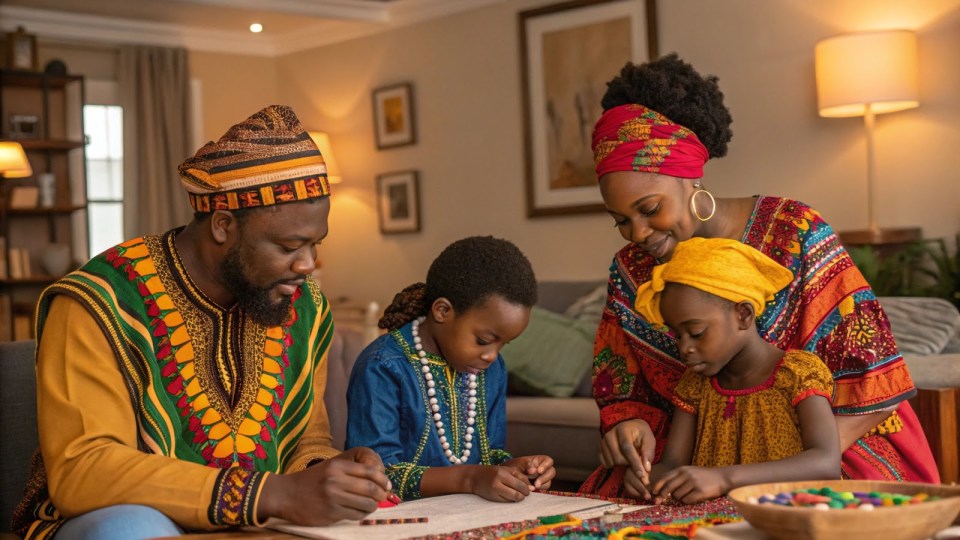In a world where stress and anxiety are constant, many Black families are turning to mindful hobbies to restore peace, strengthen connections, and support emotional wellness across generations.

Beyond simple pastimes, these creative practices anchor cultural identity and support mental health. Activities like storytelling, crafting, and shared art become everyday rituals for healing, joy, and togetherness.
Mindful hobbies deepen family bonds and offer practical tools for emotional resilience. They help create spaces where cultural traditions thrive and mental wellness is shared within Black communities.
1 – Mindful “Fun” Family Activities
Shared family routines rooted in mindfulness help build emotional closeness, reduce stress, and make space for joy. These moments don’t have to be elaborate—when done with presence, even simple activities can nurture long-term bonds.
Simple Practices That Center the Family
Introducing mindful habits into everyday life fosters emotional awareness and connection. These calming activities fit into busy schedules and support mental well-being for all ages:
- Morning reflection or meditation: To promote grounding energy at home, start the day with prayer, quiet breathing, or a moment of gratitude.
- Storytelling traditions: Revisit family history through personal tales, oral traditions, or memory-sharing nights that honor loved ones and past generations.
- Hands-on weekend crafts: Creative hobbies like drawing or knitting allow families to unwind together while building patience and self-expression. Using a premium leather knitting needle organizer can turn simple projects into peaceful skill-building opportunities.
- Cooking meaningful recipes together: Preparing a dish tied to family tradition becomes an act of storytelling, nurturing, and shared cultural pride.
- Mindful hygiene and skincare time: Encourage healthy routines by turning skincare into bonding moments—try a soothing, hydrating face spray for a healthy glow as part of a calming self-care ritual.
Every family member, regardless of age or experience, can participate meaningfully. With consistency, even short moments can evolve into influential acts of care, connection, and emotional wellness.
| Engage children in age-appropriate mindfulness: Use simple mindfulness activities for kids and teens—like mindful breathing, listening exercises, or gratitude journaling—to make mindfulness accessible and enjoyable for younger family members. |
2 – Community Leadership in Mindful Empowerment
Black communities have long embraced the power of collective healing through mindfulness. Local leaders and organizers often create safe, welcoming spaces where families engage in mindful activities that reflect cultural values.
These shared experiences strengthen family bonds and support emotional wellness across generations.
Community centers and grassroots groups offer accessible, culturally grounded mindfulness practices. These gatherings uplift families and promote healing in relevant and familiar ways.
Here are a few ways these practices bring families together and create lasting community impact:
| Mindfulness Practice | What It Involves | How It Supports |
| Meditation Circles Led by Elders | Elders guide mindfulness sessions, sharing wisdom and fostering intergenerational connections | Promotes calm, respect for elders, and shared cultural values |
| Family Yoga for All Ages | Inclusive yoga sessions are designed for all ages and ability levels to encourage whole-family participation | Enhances physical health and promotes family unity |
| Group Art Therapy | Collaborative art sessions focused on artistic expression and cultural celebration | Builds self-esteem, creativity, and a strong sense of cultural identity |
| Storytelling Sessions Exploring Heritage | Families share stories that highlight traditions, ancestry, and lived experiences through a mindful lens | Strengthens identity and nurtures intergenerational bonds |
| Breathing Exercises | Guided breathing techniques are practiced together to relieve stress and foster awareness | Improves emotional regulation and supports family harmony |
When practiced consistently, these group activities build strong support networks. Community leaders are key in sustaining them, helping families feel seen, supported, and grounded. These healing spaces benefit individuals and nurture resilient, connected neighborhoods.
3 – Embracing Cultural Heritage and Traditions

Cultural identity and tradition offer essential pathways to emotional strength and family connection. Within Black communities, these practices ground everyday life in meaning, belonging, and healing.
These core areas show how cultural heritage supports wellness:
Cultural and Racial Socialization
Teaching youth and adults to embrace Black identity helps them navigate bias and complex social dynamics.
“African American youth’s development of ethnic-racial identity by adopting a culture-specific philosophy that informs racial-ethnic socialization practices and opportunities for meaningful interpersonal interactions.”
— National Library of Medicine
Socialization promotes emotional well-being and strengthens self-worth when applied in trauma-informed settings.
Community and Spirituality
Faith, family, and community networks offer strong emotional support. Spiritual traditions, especially in the Black Church, help people find purpose and see difficulties not as threats but as challenges they can overcome.
Africultural Coping
This type of coping draws from African-centered practices, such as oral storytelling, spirituality, and harmony with nature. These traditions help reduce stress and improve life satisfaction by affirming collective values and emotional balance.
Addressing Stigma and Bias in Care
Valuing cultural strengths must go hand in hand with access to trustworthy mental health care. Recognizing community experiences and reducing provider bias help build culturally appropriate care that families can trust.
Embracing cultural traditions supports mental wellness and family unity. Black families can protect individual healing and collective strength by anchoring care in cultural knowledge, shared values, and trusted support systems.
4 – Active Listening and Empathetic Responses
Mindful listening helps family members feel heard, valued, and safe. Practicing these listening skills can foster stronger emotional bonds and healthier communication.
Key techniques include:
- Focus entirely on the speaker: Give your full attention, maintain eye contact, and minimize distractions. Pay close attention to tone, pace, and body language to show care and respect.
- Reflect to clarify: Repeat or paraphrase what was said to show you understand. This encourages openness and reinforces that you’re listening with empathy.
- Use supportive body language: Simple actions like nodding, relaxed posture, and warm facial expressions express your engagement, even without words.
- Hold space without interrupting: Let moments of silence happen. Avoid cutting in or rushing to fix the problem. This shows respect and creates room for deeper connections.
- Practice mindfulness to stay present: Techniques like deep breathing or grounding can help you stay calm and focused, making it easier to truly listen without jumping ahead.
- Create emotional safety: Active listening nurtures a secure environment. When sharing feelings without judgment is safe, healing and trust grow naturally.
When families make space for active listening and empathetic responses, they support emotional wellness and build stronger, more connected relationships rooted in trust and care.
| Create safe spaces for trauma awareness: Mindfulness instructors and family members should be aware of trauma-related reactions during mindfulness practices and create supportive environments where family members feel safe to express and process difficult emotions |
Creating a Legacy of Mindful Connection
The journey to cultivating mindfulness within black families goes beyond simple relaxation techniques – it’s about creating sacred spaces where cultural heritage and emotional wellness intersect meaningfully.
Through creative expression, shared rituals, and community engagement, families are discovering powerful ways to strengthen their bonds while nurturing mental health and resilience.
The impact of these mindful practices ripples far beyond individual families, fostering healing and connection across generations while preserving cherished traditions that celebrate Black excellence and cultural pride.
As we embrace these calming, creative pursuits, we’re not just finding peace – we’re building a legacy of emotional wellness that will uplift and inspire families for future generations.
comments +